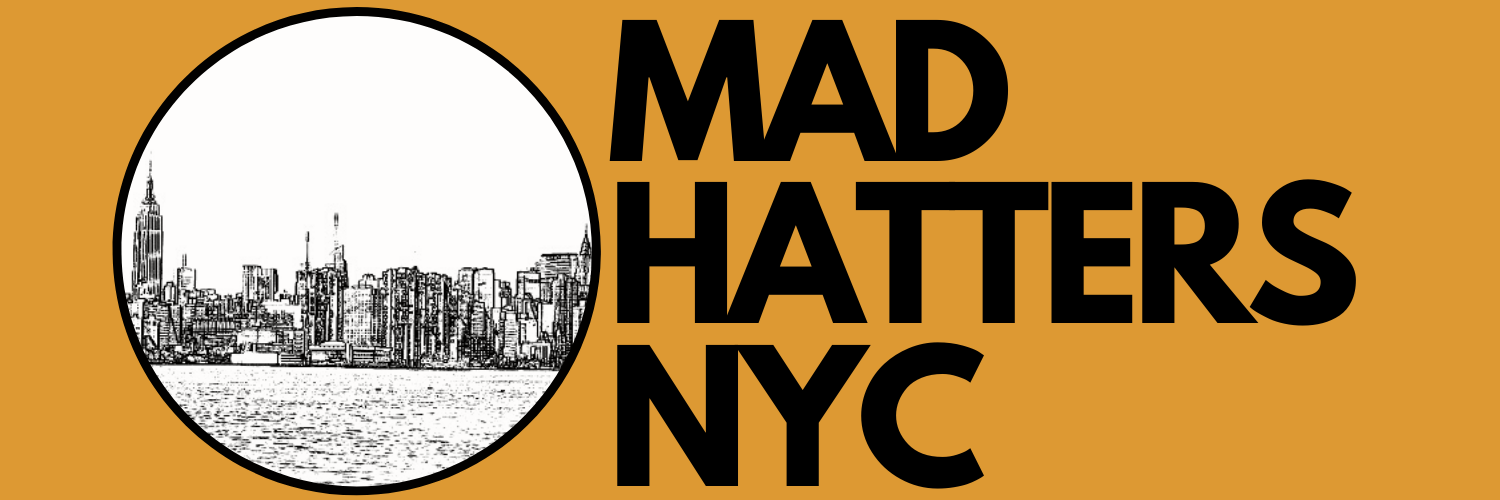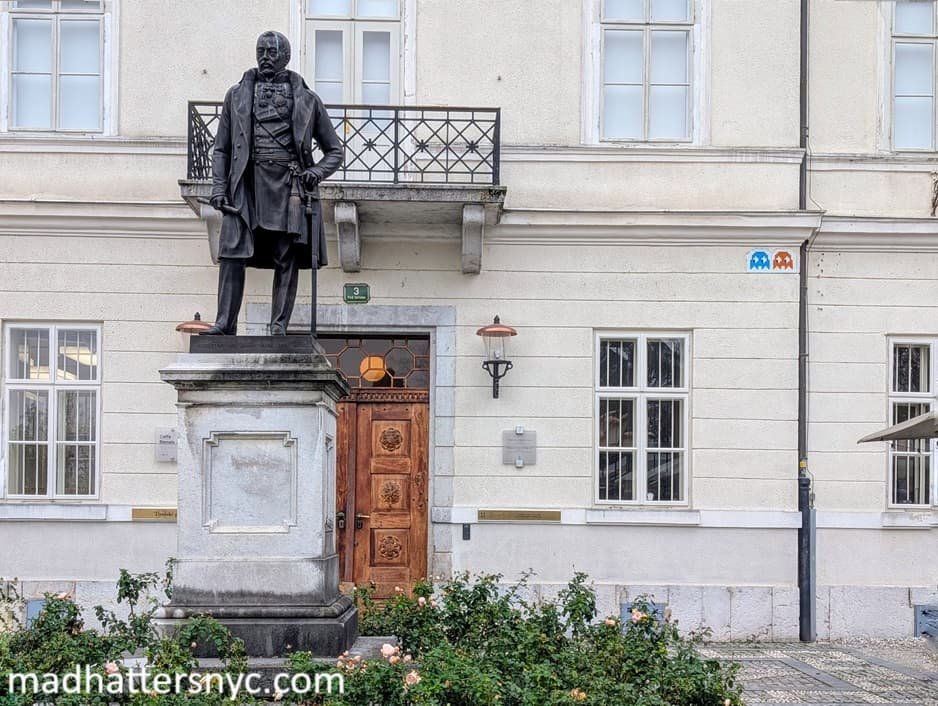A Fun Self-Guided Tour of Ljubljana with a Street Art Twist
Ljubljana is a city that feels straight out of a fairy tale, with its charming cobblestone streets, scenic riverbanks, and iconic dragon statues guarding over centuries of history. Known for its laid-back, welcoming vibe, Ljubljana is perfect to explore on foot. You can take in the medieval buildings and lush greenery while making stops along the way in the city’s many lively cafés and restaurants. This self-guided walking tour offers a fun twist; using street art by Invader to highlight the best this captivating capital has to offer.
Who is Invader?
Invader is a renowned French street artist known for his unique mosaic art, inspired by pixelated characters from the 1978 arcade game Space Invaders. Using ceramic tiles to create these distinctive mosaics, Invader transforms public spaces into playgrounds in cities all over the globe. He also created a companion app to his art called Flash Invaders, which further blurs the line between art and physical spaces and captures the nostalgia of early video games.
Invader has completed two “invasions” in Ljubljana, which resulted in a total of 42 individual “invaders”. From Bhutan to Bangkok, when Invader completes work abroad, he often partners covertly with a local to scout out locations. His mosaics are eventually removed or stolen; for example, many NYC Invaders are now tragically missing. But lucky for us, much of his work in Ljubljana has endured. Though we’re not hunting down all his invaders, you can still download the Flash Invaders app for iPhone or Android and score some points as we embark on this guided tour!
Highlights of the Walking Tour
Why opt for a self-guided tour of Ljubljana? With no strict itineraries or hurried guides, you have the freedom to wander and discover at your own leisure. Exploring at your own pace gives you the flexibility to savor every moment and create a truly personal adventure. Use the map above (full size version) as a starting point, but don’t limit yourself to these destinations and remix it any way you see fit.
Prešeren Square and the Triple Bridge
Our walking tour begins at Prešeren Square, the vibrant heart of Ljubljana and an ideal starting point. Surrounded by colorful facades and filled with the buzz of locals and tourists alike, this square is named after Slovenia’s national poet, France Prešeren. His statue stands proudly here, embodying the spirit of Slovenian culture and independence. The iconic pink Baroque structure at its center has become synonymous with Ljubljana. Featured on numerous postcards and guide books, the Franciscan Church of the Annunciation is just as impressive on the inside as it is on the outside. Open to visitors year-round, the high vaulted ceilings and beautiful frescoes make it a peaceful sanctuary in the middle of Ljubljana’s busy city center.
But take the time to admire the other beautiful structures around the square, including our personal favorite, the Hauptmann House. Named after a local paint merchant, it was built in 1873 on the site of a former 17th century tavern. In 1904 the building was renovated, with the facade and roof redesigned in the style of the modern Viennese Secession. The Vienna Secession, also known as the Union of Austrian Artists, is an art movement closely related to Art Nouveau. The five-storey corner building received an impressive facade decorated with geometric patterns of ceramic tiles in shades of green, blue and red, along with a projecting roof. In addition, captivating curved geometric sculptures were placed at the corners of the building on the first floor.
The square’s iconic Triple Bridge, designed by Ljubljana’s famed architect Jože Plečnik, is a masterpiece of both design and function, linking the city’s historical center with the modern part of town. After a massive earthquake in 1895 that devastated many buildings in the city, Plečnik was commissioned to help rebuild and modernize Ljubljana, leading to the design of many of the city’s most iconic landmarks. Take time to walk along each section of the bridge, admiring the Ljubljanica River below. And keep an eye out for our first Invader!
Pro Tip: Across the bridge, you’ll also find the Ljubljana Tourist Information Center, which is a great stop for information and recommendations. If you’re in the city for a few days, also consider the Ljubljana Card, which is one of the most comprehensive travel passes we’ve seen. It covers tours, transportation and entrance fees to multiple attractions and institutions.
Dragon Bridge
From Prešeren Square, a short stroll east along the Ljubljanica River brings you to Dragon Bridge, one of Ljubljana’s most iconic landmarks. This unusual bridge, guarded by four dragon statues, is steeped in local lore. The legend most often associated with Ljubljana’s dragons traces back to the tale of Jason and the Argonauts, the mythical Greek heroes. According to folklore, Jason and his crew were returning from their quest to find the Golden Fleece when they sailed up the Ljubljanica River and reached what is now Ljubljana. There, Jason encountered and defeated a fearsome dragon that had been terrorizing the area. This dragon-slaying tale symbolically marked the founding of the city, with the dragon becoming a guardian figure over Ljubljana.
Invader dragon street art on the wall facing the bridge
Built in 1901, this Art Nouveau bridge was one of Europe’s first concrete bridges, symbolizing Ljubljana’s shift toward modernity at the turn of the 20th century. Designed by Dalmatian architect Jurij Zaninović, the bridge is known for its striking quartet of bronze dragons. Beyond the mythology, Ljubljana’s dragons also represent resilience. For locals, the dragon embodies that spirit of survival, evolving into a cultural icon that stands for the people’s strength and perseverance. Looking north from the bridge, you’ll find our next Invader mosaic, which adds another dragon to the mix.
Central Market
Next, we’ll immerse ourselves in Ljubljana’s culinary and cultural heart at the Central Market. This bustling marketplace is a must-visit for food lovers and anyone keen to soak up local life. The market is divided into an open-air section filled with fresh produce, flowers, and artisanal products, and a covered area with stalls selling cheese, meats, and other specialties.
The market’s origins date back to medieval times, but the Central Market we know today was shaped significantly in the early 20th century, thanks to the architectural vision of Jože Plečnik. In the 1930s, Plečnik envisioned a unified market space that would serve as a central gathering point for the community. His design for the Central Market was groundbreaking, blending classical architectural styles with modern functionality. Completed in 1942, the market featured an elegant covered arcade that runs along the riverbank, and includes design elements like colonnades and arches that give the market a distinctive appearance which reflects both local culture and classical influence.
Chocolate štruklji and Pumpkin with Cheese štruklji at Moji Štruklji Slovenije
At this point in the walking tour, if you find yourself ready for lunch, then Central Market offers myriad local delicacies. We discovered štruklji, a beloved Slovenian dish consisting of rolled dough filled with a variety of ingredients. Traditionally, štruklji is made with a thin, tender dough—often similar to strudel dough—rolled around sweet or savory fillings and then baked, boiled, or steamed, depending on the regional variation and family recipe. At Moji Štruklji Slovenije, the options are seemingly endless. We sampled a seasonally appropriate pumpkin with cheese, as well as a delicious chocolate version, but we thoroughly enjoyed the hearty soups as well.
Pro Tip: If you’d prefer to sample a variety of Slovenian delicacies like local cheeses and wine, you could also consider a culinary tour!
Ljubljana Castle
Invader mosaic on St. Jacob’s Theatre
Towering above the city on Castle Hill, Ljubljana Castle is a must-visit for its essential history and incredible views. From Dragon Bridge, you can either take a 20-minute hike up a wooded path or take the funicular for a quick scenic ride. For the purposes of this walking tour, we’ll head towards the Lower Funicular Station, where another Invader mosaic awaits us on the exterior of the St. Jacob’s Theatre building. But if you’re lucky, another hidden gem awaits you here: since St. Jacob’s is home to the Ljubljana Puppet Theatre, when the clock tower chimes (reportedly every 3 hours), puppets of the fictional hero Martin Krpan and his mare pop out.
Ljubljana Castle itself is a blend of medieval architecture and modern renovations, with highlights like the Viewing Tower, the Chapel of St. George, and the Museum of Slovene History. The Viewing Tower offers a panoramic view of Ljubljana’s red-tiled rooftops and surrounding hills, while the museum offers insights into Slovenia’s past along with seasonal art exhibits.
Old Town Stroll
After the castle visit, we’ll head back down and take a leisurely stroll through Ljubljana’s Old Town. With its winding, cobblestone streets, historic buildings, and artisan shops, the Old Town is a European postcard come to life. One eye-catching highlight here is the Town Hall, an impressive structure that dates back to the late 15th century. With its clock tower, Venetian-inspired loggia, and frescoed interiors, Town Hall is a fine example of Baroque and Renaissance design. Yet another is the Robba Fountain, a marble sculpture by Italian artist Francesco Robba, created in 1751. Inspired by Rome’s famous fountains, this Baroque masterpiece represents the three rivers of Carniola (the Ljubljanica, Sava, and Krka). The original fountain is now preserved in the National Gallery, while a faithful replica remains in its place on Mestni Trg Square.
Osem Bakery on Stari Trg
But honestly, much like Zurich’s Alstadt or Oaxaca’s historic Xochimilco neighborhood, the best way to enjoy the Old Town is by wandering in and out of its incredible stores and cafés. For us food lovers, Osem Bakery offers a garden of bready delights; we visited several times for their addictive cheese straws. Meanwhile, Fetiche Patisserie has an array of tempting desserts that are almost too pretty to eat. Their specialty item is the Dragon Roll, a crusty yet flaky, filled rolled pastry available in a variety of flavors. And of course, fellow coffee fans looking for an afternoon pick-me-up should pop into Črno Zrno, whose Colombian owner-barista is friendly and welcoming, and whose espresso drinks are absolutely top-notch.
Invader topped by a dragon’s head near Škuc Gallery
As you wander the Old Town, don’t lose sight of our quest, because several Invaders reside here! Where Mestni Trg turns into Stari Trg, the north facing side of the building features a pixelated version of Ljubljana’s coat of arms, while the south facing side bears an Invader-breathing dragon. And another dragon-Invader combo is located on the corner of Stari Trg and the picturesque Gornji Trg, right above Škuc Gallery.
Tivoli Park
“Ballet” sculpture by Stojan Batic in Tivoli Park
We’ll end our walking tour with a visit to Tivoli Park, Ljubljana’s largest and most popular green space. Known for its serene landscapes, meticulously maintained gardens, and cultural landmarks, Tivoli Park offers a refreshing escape from urban life. Officially established in 1813 during the time of the Napoleonic Illyrian Provinces, the park was designed in a French formal style with expansive tree-lined avenues, symmetrical gardens, and a central promenade. In the 1930s, Jože Plečnik made significant additions to Tivoli, adding his distinct touch with classic colonnades, fountains, and carefully planned paths, creating a balance between structured design and natural beauty.
A pair of Pac-Man Ghost invaders on Tivoli Mansion’s exterior
And our final Invader-themed self-guided walking tour stop is located near the end of the tree-lined Jakopič Promenade. Tivoli Mansion is a baroque manor dating back to the 17th century. Today, it houses the International Centre of Graphic Arts which holds temporary exhibitions of graphic art and hosts the Ljubljana Biennial of Graphic Arts, one of the world’s oldest biennial events dedicated to printmaking. The exterior of the elegant mansion has a surprising addition: a pair of Invader Pac-Man ghosts. And if you have the time to spare, explore its art-filled rooms, where additional Invaders may lay in wait.
Other Things to Do in Ljubljana
Now that you’ve had a chance to explore the heart of charming Ljubljana, we encourage you to go beyond the highlights. Whether you decide to wander off the beaten path and explore side alleys and small courtyards, delve into the delightful art scene, or go on a tasting tour, you won’t run out of fun things to do in Ljubljana. Don’t miss out on some of our favorite stops below.
National Gallery of Slovenia
The National Gallery of Slovenia is Ljubljana’s premier art institution, dedicated to preserving and showcasing the rich heritage of Slovenian and European art. Located near Tivoli Park on the edge of Ljubljana’s cultural district, this elegant gallery occupies a beautifully restored neo-Renaissance building dating back to 1896, with a modern glass extension that blends historic and contemporary architecture seamlessly. Our favorite discoveries were Matija Jama and Ivan Grohar, incredible Slovene Impressionists, and Zoran Mušič, Slovenia’s preeminent contemporary artist.
Metelkova
Though our walking tour featured some street art, an absolute treasure trove can be found in Metelkova. AKC Metelkova Mesto is a self-declared autonomous cultural center in Ljubljana, renowned as one of Europe’s most dynamic hubs for alternative art, music, and social activism. Located on the site of a former Yugoslav military barracks, this eclectic, graffiti-covered complex sits just a short walk from the main train station and stands in stark contrast to Ljubljana’s more traditional historic center. Metelkova, with its chaotic, colorful energy, has become a symbol of creativity and resistance, drawing both locals and tourists interested in experiencing Ljubljana’s countercultural scene. Another gem in the area is the Museum of Contemporary Art Metelkova (+MSUM), which explores various revolutionary themes.
Plečnik House
Plečnik House is a fascinating museum and cultural site dedicated to the life and work of Jože Plečnik, the visionary architect whose designs shaped modern Ljubljana. Just a short walk from the city center, this historic residence – where the artist lived and worked from 1921 until his death in 1957 – offers a glimpse into the mind of one of Slovenia’s most celebrated creative geniuses. Both the home and the adjoining garden reflect Plečnik’s personal philosophy, artistic legacy, and meticulous approach to architecture and design.
Pro Tip: Plečnik House is only accessible by guided tour, and the tour groups are limited to seven people so they sell out quickly. Schedule your visit early to avoid disappointment!
Conclusion
Exploring Ljubljana on foot is an immersive journey through centuries of history and culture, and using Invader’s fun street art as a beacon adds a touch of whimsy to the experience. But even though there are myriad ways to explore the city, you’ll walk away realizing that Ljubljana’s charm isn’t just in its landmarks but in the small details: the friendly locals, the vibrant art, and the seamless blend of past and present. This is a city that invites you to slow down, savor, and return for more.




















